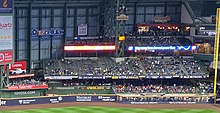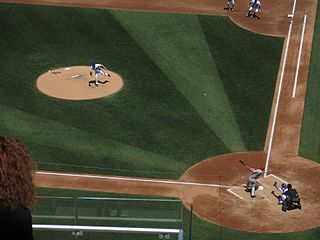
Baseball is a bat-and-ball sport played between two teams of nine players each, taking turns batting and fielding. The game occurs over the course of several plays, with each play generally beginning when a player on the fielding team, called the pitcher, throws a ball that a player on the batting team, called the batter, tries to hit with a bat. The objective of the offensive team is to hit the ball into the field of play, away from the other team's players, allowing its players to run the bases, having them advance counter-clockwise around four bases to score what are called "runs". The objective of the defensive team is to prevent batters from becoming runners, and to prevent runners' advance around the bases. A run is scored when a runner legally advances around the bases in order and touches home plate.

The Atlantic League of Professional Baseball (ALPB) is a professional independent baseball league based in the United States. It is an official MLB Partner League based in the Mid-Atlantic and Southeastern United States. The Atlantic League's corporate headquarters is located at Clipper Magazine Stadium in Lancaster, Pennsylvania.

The designated hitter (DH) is a baseball player who bats in place of another position player, most commonly the pitcher.
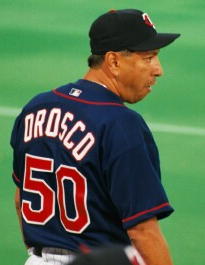
In baseball, a left-handed specialist is a relief pitcher who throws left-handed and specializes in pitching to left-handed batters, weak right-handed batters, and switch-hitters who bat poorly right-handed. Because baseball practices permanent substitution, these pitchers frequently pitch to a very small number of batters in any given game, and rarely pitch to strictly right-handed batters. Most Major League Baseball (MLB) teams have several left-handed pitchers on their rosters, at least one of whom is a left-handed specialist. A left-handed specialist is sometimes called a LOOGY, coined by John Sickels, and may be used pejoratively.

Throughout the history of baseball, the rules have frequently changed as the game continues to evolve. A few common rules most professional leagues have in common is that four balls is a base on balls, three strikes is a strikeout, and three outs end a half-inning.

In baseball, a pitcher can commit illegal motions or actions that constitute a balk. Most of these violations involve pitchers pretending to pitch when they have no intention of doing so. In games played under the Official Baseball Rules that govern professional play in the United States and Canada, a balk results in a dead ball or delayed dead ball. In certain other circumstances, a balk may be wholly or partially disregarded. In the United States, under the National Federation of State High School Associations, a balk results in an immediate dead ball. In the event a balk is enforced, the pitch is generally nullified, each runner is awarded one base, and the batter (generally) remains at bat with the previous count. The balk rule in Major League Baseball was introduced in 1898.
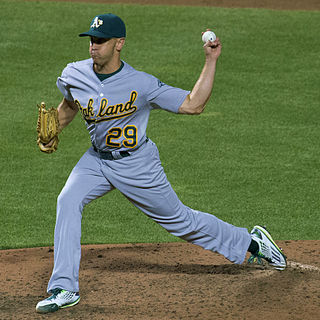
Patrick Michael Venditte Jr. is an American former professional baseball pitcher. He played in Major League Baseball (MLB) for the Oakland Athletics, Toronto Blue Jays, Seattle Mariners, Los Angeles Dodgers, San Francisco Giants, and Miami Marlins. After attending Creighton University, Venditte was drafted by the New York Yankees in 2008. He signed with the Athletics as a free agent before the 2015 season and made his MLB debut that year.
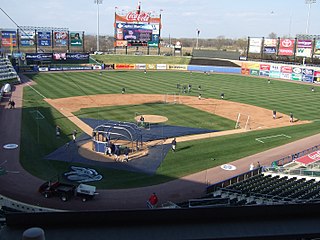
Triple-A has been the highest level of play in Minor League Baseball in the United States since 1946. Currently, two leagues operate at the Triple-A level, the International League (IL) and the Pacific Coast League (PCL). There are 30 teams, one per each Major League Baseball (MLB) franchise, with 20 in the IL and 10 in the PCL. Triple-A teams are generally located in smaller cities as well as larger metropolitan areas without MLB teams, such as Austin, Jacksonville, Columbus, and Indianapolis. Four Triple-A teams play in the same metro areas as their parent clubs.
Below are select minor league players, and the rosters of the minor league affiliates, of the San Francisco Giants:

Double-A is the second-highest level of play in Minor League Baseball in the United States since 1946, below only Triple-A. There are currently 30 teams classified at the Double-A level, one for each team in Major League Baseball, organized into three leagues: the Eastern League, the Southern League, and the Texas League.
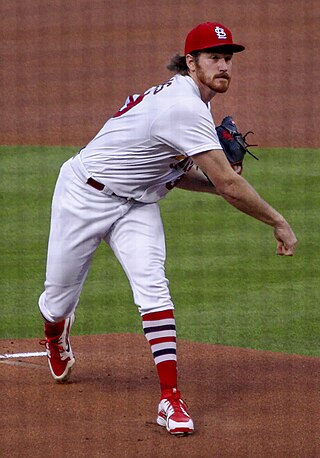
Miles Tice Mikolas, is an American professional baseball pitcher for the St. Louis Cardinals of Major League Baseball (MLB). He has previously played in MLB for the San Diego Padres and Texas Rangers, and in Nippon Professional Baseball (NPB) for the Yomiuri Giants. He was an All-Star in 2018, led the National League in wins that season, and finished sixth in NL Cy Young Award voting that year. He was also an All-Star in 2022.

Joshua Ronald Hader is an American professional baseball pitcher for the Houston Astros of Major League Baseball (MLB). He has previously played in MLB for the Milwaukee Brewers and San Diego Padres. Hader is a five-time All-Star and three-time winner of the National League Reliever of the Year Award.
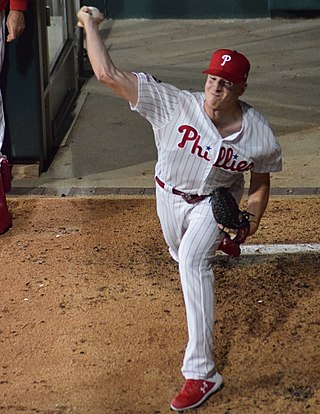
Nicholas John Carlo Pivetta is a Canadian professional baseball pitcher for the Boston Red Sox of Major League Baseball (MLB). The Washington Nationals selected Pivetta in the fourth round of the 2013 MLB draft. He was traded to the Philadelphia Phillies during the 2015 season, and made his MLB debut with them in 2017 and played with them through 2020. Listed at 6 feet 5 inches (1.96 m) and 220 pounds (100 kg), he throws and bats right-handed.

Taylor Allen Rogers is an American professional baseball pitcher for the San Francisco Giants of Major League Baseball (MLB). He has previously played in MLB for the Minnesota Twins, San Diego Padres, and Milwaukee Brewers. Rogers played college baseball at the University of Kentucky, and was selected by the Twins in the 11th round of the 2012 MLB draft. He was named an All-Star in 2021.

Jarlín Emmanuel García, nicknamed the Elephant, is a Dominican professional baseball pitcher who is a free agent. García signed as a free agent with the Miami Marlins in 2010. He made his Major League Baseball (MLB) debut in 2017 with the Marlins and has also played for the San Francisco Giants.

In baseball, pace of play refers to the length of time between in-game action, specifically the length of time a pitcher takes between their pitches. A slow pace of play can extend the length of games, which is regarded as an issue in college baseball and professional baseball. To accelerate the pace of play, leagues have instituted rule changes, such as the implementation of a pitch clock in Major League Baseball.
Hagen Jarrell Danner is an American professional baseball pitcher for the Toronto Blue Jays of Major League Baseball (MLB). He made his MLB debut in 2023.
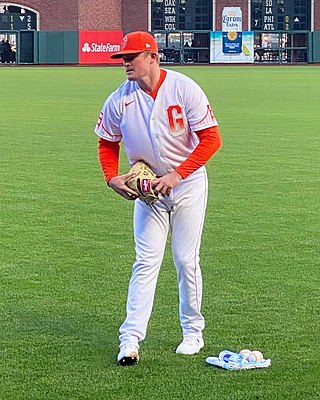
Logan Tyler Webb is an American professional baseball pitcher for the San Francisco Giants of Major League Baseball (MLB). He was drafted by the Giants out of high school in the fourth round of the 2014 MLB draft. He made his MLB debut in 2019.
Camilo Doval is a Dominican professional baseball pitcher for the San Francisco Giants of Major League Baseball (MLB). He signed with the Giants as a free agent in 2015, and made his MLB debut with them in 2021. His fastball has reached 104.5 miles per hour (168.2 km/h).

Baseball personnel have cheated by deliberately violating or circumventing the game's rules to gain an unfair advantage against an opponent. Examples of cheating include doctoring the ball, doctoring bats, electronic sign stealing, and the use of performance-enhancing substances. Other actions, such as fielders attempting to mislead baserunners about the location of the ball, are considered gamesmanship and are not in violation of the rules.

